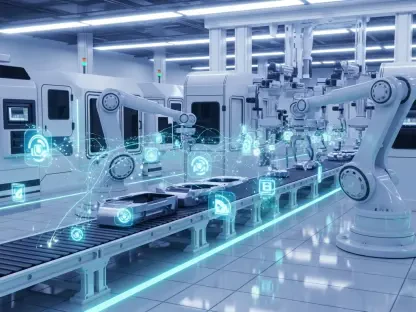The rapid evolution of technology is reshaping numerous industries, and supply chain management is no exception. Digital twins, sophisticated digital replicas of physical supply chains, are becoming cornerstones of modern logistics and operational strategies. The adoption of this revolutionary technology is set to transform future markets by optimizing efficiency, enhancing resilience, and driving profitability. This article delves into how supply chain digital twins will redefine market dynamics and lead businesses into the next era of innovation.
The Rise of Supply Chain Digital Twins
Digital twins for supply chains are intricate models that replicate real-world operations using real-time data and advanced analytics. By creating a virtual counterpart of the entire supply chain, businesses can explore various scenarios and optimize their operations for improved outcomes. Key industries such as manufacturing, retail, and logistics are at the forefront, leveraging digital twins to enhance their operational efficiency. The growing interest in supply chain digital twins is driven by the need for greater transparency, predictive capabilities, and streamlined decision-making processes.
The concept of a digital twin extends beyond mere replication. These advanced models allow organizations to simulate, predict, and visualize supply chain dynamics without incurring physical risks or costs. This ability is particularly advantageous in an increasingly complex and interconnected global market. Businesses can test different strategies within a risk-free virtual environment, leading to smarter, data-driven decisions. As companies become more adept at using these sophisticated tools, the market dynamics are expected to evolve rapidly, setting new benchmarks for operational standards.
Enhancing Operational Efficiency
One of the most significant impacts of digital twins in supply chain management is the enhancement of operational efficiency. Through detailed simulations and data analysis, businesses can identify bottlenecks, predict disruptions, and optimize logistics activities. This proactive approach allows companies to maintain lean inventories, reduce waste, and ensure smoother operations. Moreover, digital twins enable automated planning processes. Industry reports suggest that this technology can automate up to 85% of planning activities in procurement, significantly reducing manual labor and the potential for human error.
The insights generated by digital twins help organizations synchronize their supply chain activities, leading to improved productivity and cost savings. For instance, companies can better manage inventory levels by accurately forecasting demand and supply. This level of precision minimizes the risks associated with overstocking or stockouts, thereby optimizing resource utilization. Furthermore, digital twins facilitate better coordination among various stakeholders, ensuring that every part of the supply chain operates harmoniously. The result is a much more efficient and responsive supply chain that can adapt quickly to changing market conditions.
Boosting Resilience and Adaptability
In a world where supply chains are increasingly complex and interconnected, resilience and adaptability have become paramount. Digital twins provide businesses with the tools needed to anticipate and respond to disruptions effectively. By simulating potential scenarios, companies can develop strategies to mitigate risks and ensure continuity in the face of challenges such as pandemics, natural disasters, and geopolitical tensions. The ability to predict and respond to disruptions also enhances a company’s ability to adapt to changing market demands. Digital twins offer real-time visibility into supply chain operations, allowing businesses to pivot quickly and maintain a competitive edge.
This level of agility is crucial in an ever-evolving market landscape. With digital twins, businesses can prepare for various “what-if” scenarios, enabling them to make informed decisions during critical moments. For example, if a natural disaster were to disrupt a key supply route, a digital twin could help identify alternative routes and optimal resource allocations. This proactive capability not only minimizes downtime but also ensures that customer expectations are met consistently. Ultimately, supply chain digital twins transform resilience from a reactive measure into a strategic advantage, empowering companies to navigate uncertainties with confidence.
Driving Sustainability Initiatives
Sustainability is a growing concern for many organizations as they strive to reduce their environmental footprint. Supply chain digital twins play a vital role in advancing sustainability initiatives. By providing detailed insights into every aspect of the supply chain, digital twins enable companies to identify areas where they can minimize waste, reduce energy consumption, and streamline transportation logistics. Furthermore, digital twins support better coordination across the supply chain, ensuring that resources are used efficiently. This not only benefits the environment but also enhances the overall cost-effectiveness of supply chain operations.
As businesses increasingly prioritize sustainability, the adoption of digital twin technology will continue to rise. Companies can use digital twins to perform life cycle assessments, thereby identifying the most environmentally friendly options for their operations. For instance, organizations can evaluate the carbon footprint of different transportation methods and choose the most sustainable ones. Additionally, digital twins can aid in monitoring compliance with environmental regulations, thus avoiding potential legal pitfalls. In essence, digital twins bridge the gap between operational efficiency and sustainability, proving that the two can coexist harmoniously.
Integration with Advanced Technologies
The integration of digital twins with advanced technologies such as the Internet of Things (IoT) and Artificial Intelligence (AI) is a game-changer for supply chain management. IoT sensors provide real-time data on various operational aspects, feeding valuable information into digital twin systems. AI then uses this data to perform predictive analytics, offering insights that help businesses make informed decisions. These integrations significantly enhance the precision and reliability of digital twin models. With real-time data and advanced analytics, companies can achieve unprecedented transparency and control over their supply chains.
This level of detail is instrumental in optimizing operations, improving customer satisfaction, and driving business growth. For instance, AI-powered digital twins can analyze vast amounts of data to identify patterns and trends that might not be immediately apparent to human analysts. This capability enables more accurate demand forecasting, inventory management, and logistics planning. Moreover, the combination of IoT and AI allows for real-time monitoring and adjustments, ensuring that supply chain operations remain agile and responsive. As these technologies continue to advance, the potential for digital twins in supply chain management will undoubtedly expand, offering new avenues for innovation and efficiency.
Overcoming Implementation Challenges
While the benefits of supply chain digital twins are substantial, businesses must address several challenges to implement this technology effectively. Data integration is a primary hurdle, as digital twins require accurate and consistent data from diverse sources such as IoT devices and enterprise systems. Ensuring data accuracy and security is critical for the success of digital twin implementations. Another challenge is the need for a skilled workforce. The expertise required to manage digital twin technology spans data analytics, IoT, and simulation modeling.
Organizations must invest in training and development to build a team capable of leveraging digital twins to their full potential. Additionally, establishing robust data management tools and governance policies will be essential to overcoming these challenges. Companies must also navigate the complexities of integrating digital twins into their existing IT infrastructure. This process can be resource-intensive and may require significant upfront investment. However, the long-term benefits of improved efficiency, resilience, and sustainability make these efforts worthwhile. By proactively addressing these challenges, businesses can unlock the full potential of supply chain digital twins and gain a competitive edge in the market.
Future Market Potential
The fast-paced advancement of technology is having a profound impact on various sectors, with supply chain management being no exception. A notable innovation in this field is the concept of digital twins—highly detailed digital simulations of physical supply chains. These digital counterparts are poised to become essential components of contemporary logistics and operational tactics. Embracing this groundbreaking technology promises to revolutionize future markets by enhancing efficiency, boosting resilience, and increasing profitability. This article explores how implementing supply chain digital twins will alter market dynamics and guide businesses into a new era of technological innovation.
Digital twins offer a real-time, interactive model of supply chains, allowing companies to predict outcomes, identify bottlenecks, and make data-driven decisions with unprecedented accuracy. By mirroring the physical world in a virtual environment, businesses can simulate different scenarios and optimize operations without physical constraints. This not only leads to cost savings but also improves supply chain agility and responsiveness to unexpected disruptions, such as natural disasters or market fluctuations. Ultimately, the integration of digital twins into supply chain management could drive significant advancements, positioning companies at the forefront of industry innovation and market competition.









